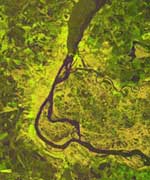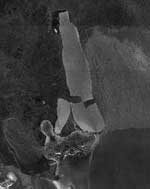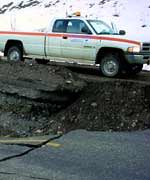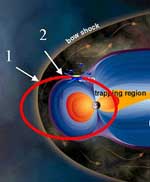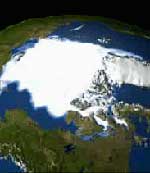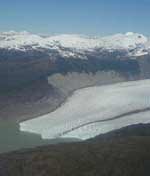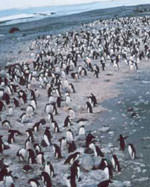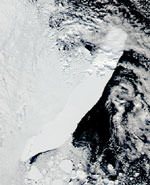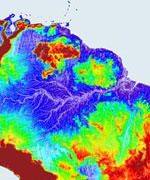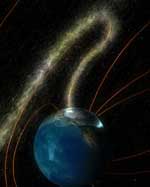
Image credit: NASA
Researchers have discovered that temporary cracks can form in the Earth’s magnetic field that can permit some of the solar wind’s energy to slip through and disrupt electronics and communications. These observations were made using NASA’s Imager for Magnetopause to Aurora Global Exploration (IMAGE) satellite, which tracked a large aurora for several hours. The ESA’s Cluster satellites flew over the same location and spotted a stream of ions slipping through a crack which normally should have been deflected by the Earth’s magnetosphere.
Immense cracks in the Earth’s magnetic field remain open for hours, allowing the solar wind to gush through and power stormy space weather, according to new observations from the IMAGE and Cluster satellites.
The cracks were detected before but researchers now know they can remain open for long periods, rather than opening and closing for just very brief intervals. This new discovery about how the Earth’s magnetic shield is breached is expected to help space physicists give better estimates of the effects of severe space weather.
“We discovered that our magnetic shield is drafty, like a house with a window stuck open during a storm,” said Dr. Harald Frey of the University of California, Berkeley, lead author of a paper on this research published Dec. 4 in Nature. “The house deflects most of the storm, but the couch is ruined. Similarly, our magnetic shield takes the brunt of space storms, but some energy continually slips through its cracks, sometimes enough to cause problems with satellites, radio communication, and power systems.”
“The new knowledge that the cracks are open for long periods, instead of opening and closing sporadically, can be incorporated into our space weather forecasting computer models to more accurately predict how our space weather is influenced by violent events on the Sun,” said Dr. Tai Phan, also of UC Berkeley, co-author of the Nature paper.
The solar wind is a stream of electrically charged particles (electrons and ions) blown constantly from the Sun (Image 1). The solar wind transfers energy from the Sun to the Earth through the magnetic fields it carries and its high speed (hundreds of miles/kilometers per second). It can get gusty during violent solar events, like Coronal Mass Ejections (CMEs), which can shoot a billion tons of electrified gas into space at millions of miles per hour.
Earth has a magnetic field that extends into space for tens of thousands of miles, surrounding the planet and forming a protective barrier to the particles and snarled magnetic fields the Sun blasts toward it during CMEs. However, space storms, which can dump 1,000 billion watts — more than America’s total electric generating capacity — into the Earth’s magnetic field, indicated that the shield was not impenetrable.
In 1961, Dr. Jim Dungey of the Imperial College, United Kingdom, predicted that cracks might form in the magnetic shield when the solar wind contained a magnetic field that was oriented in the opposite direction to a portion of the Earth’s field. In these regions, the two magnetic fields would interconnect through a process known as “magnetic reconnection,” forming a crack in the shield through which the electrically charged particles of the solar wind could flow. (Image 2 illustrates the crack formation, and Animation 1 shows how solar wind particles flow through the crack by following invisible magnetic field lines.) In 1979, Dr. Goetz Paschmann, of the Max Planck Institute for Extraterrestrial Physics, Germany, detected the cracks using the International Sun Earth Explorer (ISEE) spacecraft. However, since this spacecraft only briefly passed through the cracks during its orbit, it was unknown if the cracks were temporary features or if they were stable for long periods.
In the new observations, the Imager for Magnetopause to Aurora Global Exploration (IMAGE) satellite revealed an area almost the size of California in the arctic upper atmosphere (ionosphere) where a 75-megawatt “proton” aurora flared for hours (Image 4). This aurora, energetic enough to power 75,000 homes, was different from the visible aurora known as the Northern and Southern lights. It was generated by heavy particles (ions) hitting the upper atmosphere and causing it to emit ultraviolet light, which is invisible to the human eye but detectable by the Far Ultraviolet Imager on IMAGE. (Image 6 and Animation 4 show IMAGE’s observations of the proton aurora).
While the aurora was being recorded by IMAGE, the 4-satellite Cluster constellation flew far above IMAGE, directly through the crack, and detected solar wind ions streaming through (Image 5). Normally, these solar wind ions would be deflected by Earth’s shield (Image 3), so Cluster’s observation showed a crack was present. This stream of solar wind ions bombarded our atmosphere in precisely the same region where IMAGE saw the proton aurora. The fact that IMAGE was able to view the proton aurora for more than 9 hours, until IMAGE progressed in its orbit to where it could not observe the aurora, implies that the crack remained continuously open. (Animation 2 shows how the spacecraft worked together to reveal the crack.) Estimating from the IMAGE and Cluster data, the crack was twice the size of the Earth at the boundary of our magnetic shield, about 38,000 miles (60,000 km) above the planet’s surface. Since the magnetic field converges as it enters the Earth in the polar regions, the crack narrowed to about the size of California down near the upper atmosphere.
IMAGE is a NASA satellite launched March 25, 2000 to provide a global view of the space around Earth influenced by the Earth’s magnetic field. The Cluster satellites, built by the European Space Agency and launched July 16, 2000, are making a three-dimensional map of the Earth’s magnetic field.
Original Source: NASA News Release

